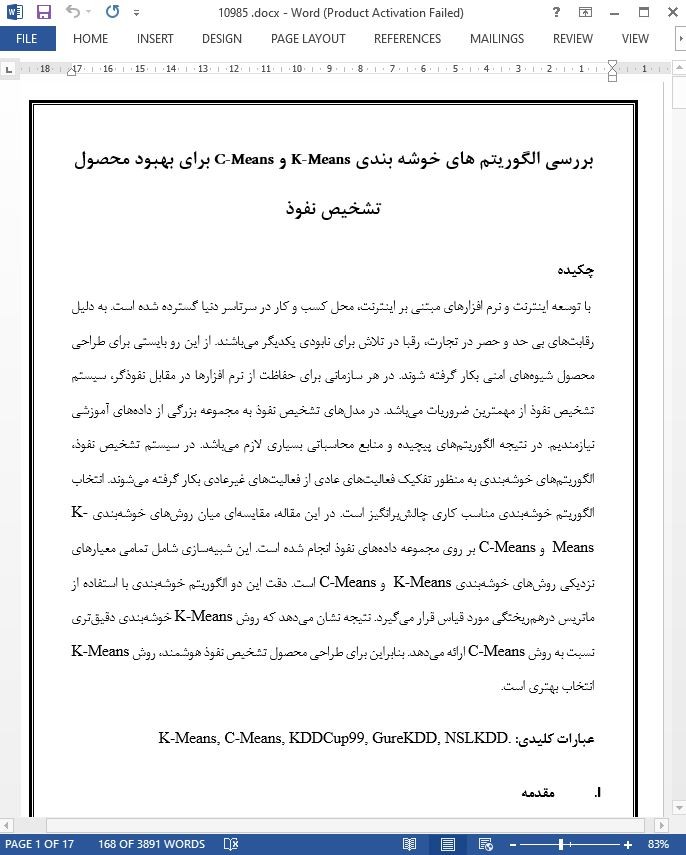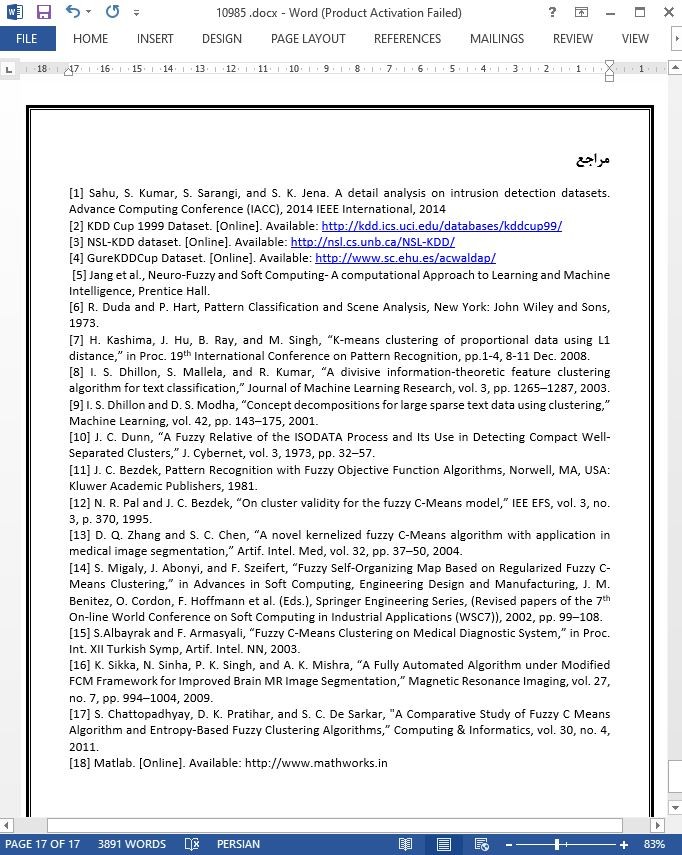
بررسی الگوریتم های خوشه بندی K-Means و C-Means برای بهبود محصول تشخیص نفوذ
چکیده
با توسعه اینترنت و نرم افزارهای مبتنی بر اینترنت، محل کسب و کار در سرتاسر دنیا گسترده شده است. به دلیل رقابتهای بی حد و حصر در تجارت، رقبا در تلاش برای نابودی یکدیگر میباشند. از این رو بایستی برای طراحی محصول شیوههای امنی بکار گرفته شوند. در هر سازمانی برای حفاظت از نرم افزارها در مقابل نفوذگر، سیستم تشخیص نفوذ از مهمترین ضروریات میباشد. در مدلهای تشخیص نفوذ به مجموعه بزرگی از دادههای آموزشی نیازمندیم. در نتیجه الگوریتمهای پیچیده و منابع محاسباتی بسیاری لازم میباشد. در سیستم تشخیص نفوذ، الگوریتمهای خوشهبندی به منظور تفکیک فعالیتهای عادی از فعالیتهای غیرعادی بکار گرفته میشوند. انتخاب الگوریتم خوشهبندی مناسب کاری چالشبرانگیز است. در این مقاله، مقایسهای میان روشهای خوشهبندی K-Means و C-Means بر روی مجموعه دادههای نفوذ انجام شده است. این شبیهسازی شامل تمامی معیارهای نزدیکی روشهای خوشهبندی K-Means و C-Means است. دقت این دو الگوریتم خوشهبندی با استفاده از ماتریس درهمریختگی مورد قیاس قرار میگیرد. نتیجه نشان میدهد که روش K-Means خوشهبندی دقیقتری نسبت به روش C-Means ارائه میدهد. بنابراین برای طراحی محصول تشخیص نفوذ هوشمند، روش K-Means انتخاب بهتری است.
I. مقدمه
در حال حاضر طراحی محصولات نرم افزاری هوشمند که در برابر حملات روزانه دوام آورند، بسیار ضروری است. برای هر شرکت نرم افزاری، توسعه آینده نگرانه محصول ضروری ترین مساله است. شرکت ها بایستی به این مساله توجه کنند که محصولشان چگونه در محیط واسطه ی ناامنی مانند اینترنت دوام خواهد آورد. برای تاب آوردن این محصولات در برابر فعالیت های نامعمول، نیازمند مفاهیم علمی مختلفی هستیم.
اصطلاح نفوذ مجموعه ی اقداماتی را شامل می شود که محرمانگی، صحت و دسترسی به منابع اطلاعاتی را به خطر می اندازد. تشخیص نفوذ فرآیند نظارت بر فعالیت های در حال انجام در شبکه و بررسی بسته های (پکت ) ورودی یا خروجی شبکه می باشد. سیستم تشخیص نفوذ این فرآیند را به طور خودکار انجام داده و از اقدامات نفوذی مقابله می کند. این اقدامات ممکن است از درون سیستم یا خارج از آن صورت گرفته باشند. نفوذگرها را می توان به انواع clandestine، misfeasor و masquerader [1] تقسیم بندی کرد.
V نتیجه گیری
در این مقاله دو روش خوشه بندی بر اساس مجموعه داده های نفوذ بررسی شده اند. این روش های خوشه بندی توسط مجموعه داده های نفوذ با معیارهای فاصله متفاوت پیاده سازی، محاسبه و مقایسه شده اند. مقایسه انجام شده در این مقاله حول دقت خوشه بندی دو روش مذکور تمرکز کرده و با ملاحظه دقیق در محاسبات مربوط به دقت و سایر معیارهای کارایی انجام شده است. به این نتیجه رسیدیم که الگوریتم خوشه بندی K-Means بر روی این مجموعه داده ها، دقت بیشتر و با صرف مدت زمان کوتاهتری نسبت به الگوریتم خوشه بندی C-Means ارائه می دهد.
نیازی نیست که روش های خوشه بندی مورد مطالعه در این مقاله، به تنهایی برای پیش بینی حملات مورد استفاده قرار بگیرند. نظر به اینکه مراکز ثقل به طور تصادفی انتخاب می شوند، کلاس افرازبندی هم ممکن است تغییر کرده یا در هر اجرا تکامل یابد. بنابراین برای دستیابی به دقت بالاتر بهتر است با سایر الگوریتم های داده کاوی بصورت تلفیقی استفاده شود.
Abstract
The increase in Internet and Internet based application, the business premises have now spread throughout the world. Due to the extreme competitions among the business, one tries to demolish other. Hence, secure product design techniques should be adopted. To protect the applications from intruder, intrusion detection system becomes utmost requirement for every organization. In intrusion detection models enormous quantity of training data is required. As a result, sophisticated algorithms and high computational resources are required. In Intrusion Detection System, to separate normal activities from abnormal activities clustering algorithms are used. To select an efficient clustering algorithm is a challenging task. In this paper, a comparison has been made between K-Means and C-Means clustering on intrusion datasets. The simulation contains all proximity measures of K-Means and C-Means clustering techniques. The accuracy of these clustering algorithms is compared using the confusion matrix. The result shows that K-Means provides better clustering accuracy in comparison with C-Means. Therefore, to design intelligent intrusion detection product K-Means is a better option.
I. INTRODUCTION
In the present day it is highly essential to design intelligence software products which can withstand zero day attacks. The innovative product development is utmost essential to every software firm. They should focus on how the product is survive in an insecure medium like the internet. Interdisciplinary concepts are required to tolerate the unusual activities. The term intrusion comprises a set of attempts to compromise the confidentiality, integrity and availability of information resources. Intrusion detection is the process of monitoring the events in the system and analyzing the network packets to or from the network. Intrusion detection system automates the process and counteract the intrusive efforts. The intrusive efforts can be caused by insiders or outsiders in the system. The intruder can be classified as clandestine, misfeasor and masquerader [1].
V. CONCLUSION
Two clustering techniques based on intrusion datasets have been reviewed in this paper. These clustering techniques with different similarity measures are implemented, evaluated and compared using intrusion datasets. The comparative study discussed here is concerned with the accuracy of each algorithm, with care being taken towards the accuracy in calculation and other performance related measures. It is found that the K-Means clustering algorithm provides better accuracy and consumes less time in comparison to C-Means clustering on these datasets.
The clustering techniques discussed here don’t have to be used alone to predict different attacks. As the initial centroids are chosen randomly, the class distribution may change or evolve on each execution. Therefore, it should be used in conjunction with other data mining algorithms for better accuracy.
چکیده
I مقدمه
II روش های خوشه بندی
III پیاده سازی
IV بررسی و نتیجه گیری
V نتیجه گیری
Abstract
I. INTRODUCTION
II. CLUSTERING TECHNIQUES
III. IMPLEMENTATION
IV. RESULT AND DISCUSSION
V. CONCLUSION
- ترجمه فارسی مقاله با فرمت ورد (word) با قابلیت ویرایش، بدون آرم سایت ای ترجمه
- ترجمه فارسی مقاله با فرمت pdf، بدون آرم سایت ای ترجمه



